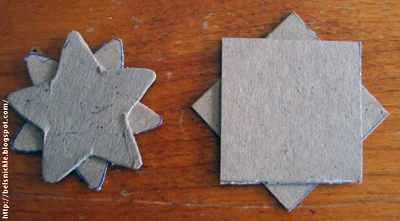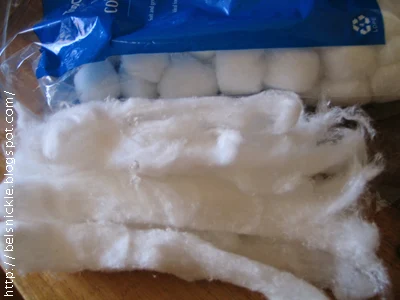 |
| I discovered this little vintage, yo yo clown stuffed inside a bag of fabric remnants in a resale shop. What a unpredictable yet happy purchase I had made! |
Important Tips:
- Keep some Bandaids, peroxide and a couple of thimbles on hand, just to be on the safe side.
- Make sure that all of the needles used in a project made by a younger family member are brand new.
- New sewers need to be guided by an adult in order to complete the project. The project takes two, a parent and a preteen working together!
- three circle stencils
- fabric scraps (laundered and machine dried)
- scissors
- one finer needle and matching threads or quilter's thread
- one large embroidery needle
- embroidery floss for facial features
- 1 skein of red yarn for pom poms
- 36 inches of red ribbon for collar trim
- 2 inch wide cardboard strip
- cotton batting filler
- Prepare your fabric scraps if you have not already done so for former projects. The fabric needs to have it's sizing removed in the laundry. Plus the fabric should also be preshrunk. By laundering the fabric you will prevent shrinking and tearing in the future should you ever need to wash the toy after baby handles it. This preparation also prevents bright dyes from "bleeding" onto lighter colored fabrics in the wash.
- Cut circle templates or patterns whose diameters measure: 1 inch, 1 1/2 inches and 2 inches. Trace and cut out 28- 1 inch circles, 32- 1 1/2 inch circles and 17- 2 inch circles from your scrap fabric for the clown's body. An additional helpful video for this project is by Wendy Harbaugh.
- Thread and knot your needle to begin sewing your first yo yo. Holding the wrong side of the fabric circle up, use large stitches to turn down the raw edges as you work around the inside of the circle. Then gather the edges together and gently pull them to the circle's center to make a puff.
- Now work the needle through the the gathered edge on the right side of the fabric to reinforce the gathering, tightening it up as you go without sewing through the gathering to the right side of your yo yo.
- Backstitch over your work and snip off the thread. Set the yo yos aside for stringing later.
- Make four red pom poms measuring approximately 2 inches in diameter. Wrap yarn around a piece of 2 inch wide cardboard at least 50 times, pass a small piece of yarn through the center of this wrapping and remove the cardboard. Tie the yarn tightly to bind together the twisted mass and then clip all of the loops to make your pom poms. Be sure to trim the pom pom in order to make a more uniform looking pom pom for your doll's hands and feet. Click here to view a video that demonstrates how to make a pom pom with your hands.
- Use a thick thread to string the body together. Knot the end of your thick thread and string it first through one pom pom and then thread together 16 - 1 1/2 inch yo yos for each leg. Then take the ends of each of these threads used to string the legs and insert them into the eye of a large embroidery needle. On this combined threading add the 16- 2 inch yo yos. Stringing carefully through the center of each. After completing this stage of the stringing, neatly tie off the threaded ends and then sewing them down firmly to the last yo yo's right side. You should have one 2 inch yo yo left that was not strung onto the torso of your clown.
- String together a pom pom and 14 - 1 1/2 inch yo yos for an arm. Repeat for the second arm. Attach each arm using the stringing thread to the last 2 inch yo yo of the torso.
- Take the remaining, left over 2 inch yo yo and neatly attach this on top of all of the exposed threads at the end of the clown's torso. This will hide this part of your stringing ends. You may choose to sew this yo yo down through the back side of the top yo yo in order to make a firmer finish.
- Now cut a strip of any fabric 2 inches wide and 27 inches long for the ruffled collar of the clown. Fold a ribbon over one raw edge concealing it and run a straight stitch on top of the ribbon.
- Gather this collar piece and whip stitch it securely to the end yo yo piece where the head of the clown will be attached.
- Cut a 4 inch in diameter, circular, solid colored piece of fabric for the clown's head. Gather this large yo yo's edges as before and finish the puff. Stuff cotton batting through this yo yo's small hole with the tip of your scissors until his head is filled firmly. Take a pencil and draw a face and embroider his features as you prefer. Attach the head using a slip stitch to the top of the clowns collar.
- To sew the clown's hat, cut a very long triangular shape, sewing together the longest two sides. Attach this to his head turning under the raw edges of the cap as you use a slip stitch to attach the hat to his head permanently. You can cover this edge with a bit of extra red ribbon used to make the collar.
- Make a tiny pom pom for the tip of his hat. Stitch it on firmly babies may try to eat!















































